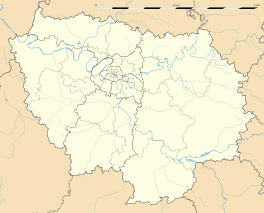La Roche-Guyon
| La Roche-Guyon | ||
|---|---|---|
| Commune | ||

La Roche-Guyon, the castle and the keep
|
||
|
||
| Coordinates: 49°04′56″N 1°37′49″E / 49.0822°N 1.6303°ECoordinates: 49°04′56″N 1°37′49″E / 49.0822°N 1.6303°E | ||
| Country | France | |
| Region | Île-de-France | |
| Department | Val-d'Oise | |
| Arrondissement | Pontoise | |
| Canton | Vauréal | |
| Intercommunality | Vexin Val de Seine | |
| Government | ||
| • Mayor (2001–2008) | Alain Quenneville | |
| Area1 | 4.61 km2 (1.78 sq mi) | |
| Population (2006)2 | 533 | |
| • Density | 120/km2 (300/sq mi) | |
| Time zone | CET (UTC+1) | |
| • Summer (DST) | CEST (UTC+2) | |
| INSEE/Postal code | 95523 /95780 | |
| Elevation | 13–143 m (43–469 ft) | |
|
1 French Land Register data, which excludes lakes, ponds, glaciers > 1 km² (0.386 sq mi or 247 acres) and river estuaries. 2Population without double counting: residents of multiple communes (e.g., students and military personnel) only counted once. |
||
1 French Land Register data, which excludes lakes, ponds, glaciers > 1 km² (0.386 sq mi or 247 acres) and river estuaries.
La Roche-Guyon is a commune in the Val-d'Oise department in Île-de-France in northern France.
The commune grew around the Château de La Roche-Guyon, upon which historically it depended for its existence. The commune's population in 1999 was 550.
The present Château de La Roche-Guyon was built in the 12th century, controlling a river crossing of the Seine, itself one of the routes to and from Normandy; The Abbé Suger described its grim aspect: "At the summit of a steep promontory, dominating the bank of the great river Seine, rises a frightful castle without title to nobility, called La Roche. Invisible on the surface, it is hollowed out of a high cliff. The able hand of the builder has established in the mountainside, digging into the rock, an ample dwelling provided with a few miserable openings". In the mid-13th century, a fortified manor house (the château-bas) was added below. Guy de La Roche fell at the Battle of Agincourt, and his widow was ousted from the Roche, after six months of siege, in 1419; she preferred to depart rather than accept Henry Plantagenet as her overlord. It came to the Liancourt family with the marriage of Roger de Plessis-Liancourt to the heiress Marie de La Roche; he was a childhood companion of Louis XIII, first gentleman of the Chambre du Roi, and was made a duke in 1643. He and his wife made great changes to the château-bas, opening windows in its structure and laying out the terrace to the east, partly cut into the mountain's steep slope.
The domain of La Roche-Guyon came to the La Rochefoucauld family in 1669, with the marriage of Jeanne-Charlotte de Plessis-Liancourt with François VII de La Rochefoucauld. The Château retained its medieval aspect of a fortress, with its moat and towers and cramped, dark living apartments. The Château was largely extended in the 18th century.
...
Wikipedia



